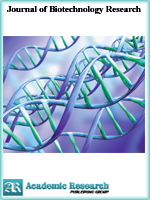Journal of Biotechnology Research
Online ISSN: 2413-3256
Print ISSN: 2413-8878
Print ISSN: 2413-8878
Quarterly Published (4 Issues Per Year)

Archives
Volume 2 Number 6 June 2016
Green Computing for Eco Enriched Information Services and Systems: Environmental & Bio Informatics Perspective
Authors: P. K. Paul ; A. Bhuimali ; R. Rajesh ; K. L. Dangwal ; P. Das ; J. Ganguly
Pages: 44-48
Abstract
Green Computing is one of the emerging concept and practice towards design and development and maintenance of computing and information system which are eco friendly, releases less harmful material and chemical and based on less carbon [CO2] emission. Green Computing is the practice of using computing resources efficiently. Green Computing can facilitate safe, secure place and improved environment all over in the world. Virtually Global temperature is increasing day by day and Electronic goods are many ways responsible for such; hence technologist and scientists are dedicated to building sustainable electronic product and system worldwide. This paper is talks about Green Computing including its nature and feature and requirement. Paper highlighted the bad side of Electronic and Computing goods and side by side possibilities to overcome such Electronic Goods.
Antimicrobial Activity of Citrullus Lanatus (Watermelon) Seeds on Some Selected Bacteria
Authors: Bello, H. S. ; Ismail, H. Y. ; Goje, M. H. ; Mangga, H. K.
Pages: 39-43
Abstract
Plants are reservoirs of different kinds of phytochemicals used for treatment of infections and other diseases. This study was aimed at evaluating the phytochemical and antimicrobial activity of Citrullus lanatus (watermelon) seeds against some selected bacteria. Water and ethanol were used to obtain the extracts and they were analyzed for the presence of alkaloids, flavonoids, glycosides, tannins and saponins. Out of the phytochemicals screened, only saponins were not detected in both aqueous and ethanolic extract. Staphylococcus aureus, Escherichia coli, Pseudomonas aeruginosa and Klebsiella pneumoniae were selected for antibiotic susceptibility testing. Antibacterial activity revealed that S. aureus, E. coli, and P. aeruginosa were most susceptible to the extracts at concentrations ranging from 6.25mg/ml to 50mg/ml. Klebsiella pneumoniae was observed to be resistant especially to the ethanolic extract. Largest zone of inhibition (8 mm) was produced against P. aeruginosa using aqueous extract at 50mg/ml. Higher concentrations were generally efficacious than the lower concentration whereas, ciprofloxacin (control) exert better activity than either of the extracts. Results for the MIC and MBC suggest that the constituents of the extract could be bactericidal as they were in close range. The findings of this study showed that seeds of C. lanatus contained bioactive compounds with potent antibacterial activity and thus could be used as herbal preparations just as the other parts of the plant.



